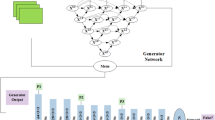Abstract
Air quality is widely concerned by the governments and people. To save cost, air quality monitoring stations are deployed at only a few locations, and the stations are actuated at partial time. Therefore, it is necessary to study how to actively collect a subset of air quality data to maximize the estimation accuracy of air quality at other locations and time. In order to solve this challenge, we propose the active variational adversarial model (AVAM) that selects the most valuable unlabeled samples through two iterative phases of active learning. In the first phase of our model, a candidate set with unlabeled samples is selected through traditional active learning. In the second phase, variational auto-encoder (VAE) is used to obtain the compressed representation of the candidate set and the training set with labeled samples, then a discriminator based on three-layer neural network is trained from the compressed representation. Finally the discriminator can output the most valuable unlabeled samples from the candidate set. The experimental results show that the AVAM proposed in this paper is superior to active learning models with the first or second phase only.
Access this chapter
Tax calculation will be finalised at checkout
Purchases are for personal use only
Similar content being viewed by others
References
Settles, B.: Active Learning Literature Survey. Computer Sciences Technical Report 1648, University of Wisconsin–Madison (2009)
Rana, R.K., Chou, C.T., Kanhere, S.S., Bulusu, N., Hu, W.: Ear-phone: an end-to-end participatory urban noise mapping system. In: 9th International Conference on Information Processing in Sensor Network (IPSN), pp. 105–116 (2010)
Zhu, Y., Li, Z., Zhu, H., Li, M., Zhang, Q.: A compressive sensing approach to urban traffic estimation with probe vehicles. IEEE Trans. Mob. Comput. 12, 2289–2302 (2013)
Yang, S., Shi, S., Hu, X., M, Wang: Spatiotemporal context awareness for urban traffic modeling and prediction: sparse representation based variable selection. PLoS ONE 10(10), e0141223 (2015)
Zheng, Y., Liu, F., Hsieh, H.P.: U-air: when urban air quality inference meets big data. In: 19th ACM SIGKDD International Conference on Knowledge Discovery and Data Mining(KDD), pp. 1436–1444 (2013)
Burrows, W.R., Benjamin, M., Beauchamp, S., Lord, S., McCollor, E.R., Thomson, B.: CART decision-tree statistical analysis and prediction of summer season maximum surface ozone for the vancouver, montreal, and atlantic regions of canada. J. Appl. Meteorol. 34(8), 1848–1862 (2010)
Subcommittee S T C A Q. Air Quality Forecasting: A Review of Federal Programs and Research Needs. Environmental Policy Collection (2001)
Song, Y.C., Zhen, S.: Application of BP neural network and time series model in air quality prediction of Baotou city. J. Arid Land Res. Environ. 27(7), 65–70 (2013)
Zhu, C.L., Jiang, Z.F., Wang, Q.: A prediction model of ambient air quality based on B-P neural network. Comput. Eng. Appl. 22, 223–227 (2007)
Lin, K., Shao, F.: Study on air quality prediction based on random forest and neural network. J. Qingdao Univ. (Eng. Technol. Ed.) 33(02), 32–36 (2018)
Qian, M.: Classification and prediction of air quality based on random forest perspective. J. Chongqing Technol. Bus. Univ. (Nat. Sci. Ed.) 35(03), 30–34 (2018)
Su, J., Wu, H.P.: Predicting the change trend of ambient air quality by using grey theory model - taking the prediction of ambient air quality in Jingjiang city as an example. Pollut. Control Technol. 23(04): 10–12 + 22 (2010)
Yang, J.W., Sun, B.L.: The prediction of air pollutant concentration in Pingdingshan city based on grey Markov model. Math. Pract. Theor. 44(02), 64–70 (2014)
Chang, H., Yu, Z., Yu, Z.: Air quality estimation based on active learning and Kriging interpolation. Big Data 4(06), 57–67 (2018)
Iglesias, J.E., Konukoglu, E., Montillo, A., Tu, Z., Criminisi, A.: Combining generative and discriminative models for semantic segmentation of CT scans via active learning. Inf Process Med Imaging 22, 25–36 (2011)
Wang, D., Shang, Y.: A new active labeling method for deep learning. In: 2014 International Joint Conference on Neural Networks (IJCNN). IEEE (2014)
Gal, Y.: Uncertainty in deep learning. University of Cambridge (2016)
Gal, Y., Islam, R., Ghahramani, Z.: Deep Bayesian Active Learning with Image Data (2017)
Yoo, D., Kweon, I.S.: Learning loss for active learning. In: Proceedings of the IEEE Conference on Computer Vision and Pattern Recognition (2019)
Sinha, S, Ebrahimi, S., Darrell, T.: Variational Adversarial Active Learning (2019). arXiv preprint arXiv:1904.00370
Tran, T., Do, T.T., Reid, I., et al.: Bayesian Generative Active Deep Learning (2019). arXiv preprint arXiv:190411643
Zheng, Yu., et al.: Forecasting fine-grained air quality based on big data. In: Proceedings of the 21th ACM SIGKDD International Conference on Knowledge Discovery and Data Mining. ACM (2015)
Wang, D., Cao, W., Li, J., Ye, J.: DeepSD: supply-demand prediction for online car-hailing services using deep neural networks. In: 2017 IEEE 33rd International Conference on Data Engineering (ICDE). IEEE (2017)
Kingma, D.P., Welling, M.: Auto-encoding variational bayes (2013). arXiv preprint arXiv:13126114
Kingma, D.P., Ba, J.: Adam: a method for stochastic optimization. In: International Conference on Learning Representations (2015)
Acknowledgement
This work is supported by the National Natural Science Foundation of China under grant No. 61772136.
Author information
Authors and Affiliations
Corresponding author
Editor information
Editors and Affiliations
Rights and permissions
Copyright information
© 2020 Springer Nature Switzerland AG
About this paper
Cite this paper
Lei, D., Yu, Z., Li, P., Han, L., Huang, F. (2020). Using Deep Active Learning to Save Sensing Cost When Estimating Overall Air Quality. In: Yu, Z., Becker, C., Xing, G. (eds) Green, Pervasive, and Cloud Computing. GPC 2020. Lecture Notes in Computer Science(), vol 12398. Springer, Cham. https://doi.org/10.1007/978-3-030-64243-3_15
Download citation
DOI: https://doi.org/10.1007/978-3-030-64243-3_15
Published:
Publisher Name: Springer, Cham
Print ISBN: 978-3-030-64242-6
Online ISBN: 978-3-030-64243-3
eBook Packages: Computer ScienceComputer Science (R0)




